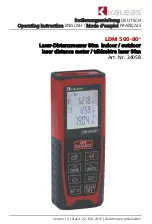
stewmac.com
Lightly smooth the frets with a smooth mill file, a carborun-
dum stone, or a hard block with 400-grit sandpaper . A few
gentle passes should be all it takes, and the result will be a
tiny flat mark on each fret top . Check with a straightedge to
see that the frets are level, and use a hardwood block with
600-grit sandpaper to remove any filing marks .
Finally, smooth the frets with a piece of 1000-grit sandpa-
per wrapped around two fingers . The action of your fingers
over the frets will round them a little while it burnishes and
polishes the tops . Roll over the fret ends also to polish them
and remove any burrs .
Level and polish the frets
With lighter fluid, clean the tuning keys (not included) to
remove grease or oil, then dry them . Mark the mounting hole
locations with an awl . Drill the screw holes to match your
mounting screws (usually a 1/16" hole) . Use a piece of mask-
ing tape on the drill bit to mark the screw-hole depth .
Install the tuners
It’s time to shape the edges of the top and back to match
the sides . If your rough-shaping of the top and back left a
lot of wood exposed, you’ll want to saw it away now so that
you have a small overhang around the sides (approximately
1/8") . Remove the overhang with a hand plane, or a knife and
file . Trim with the grain, to avoid splitting the wood .
Trim the top and back overhang and sand the body
Bushings may be supplied with the tuners you choose . They
are not really necessary, and to properly install them requires
a special drill bit or reamer .
Protect the sides with a layer or two of masking tape in case
you slip, then remove the tape when you sand the edges .
Use the sanding stick with 80-grit on one end and 150-grit
on the other to smooth the edges and round any flat spots
on the sides . Sand carefully, and sand as little as possible in
the neck block area, to avoid changing the shape for neck-
fitting . Use the 80-grit for shaping if necessary, but switch
to 150-grit for smoothing as soon as you can .
14









































